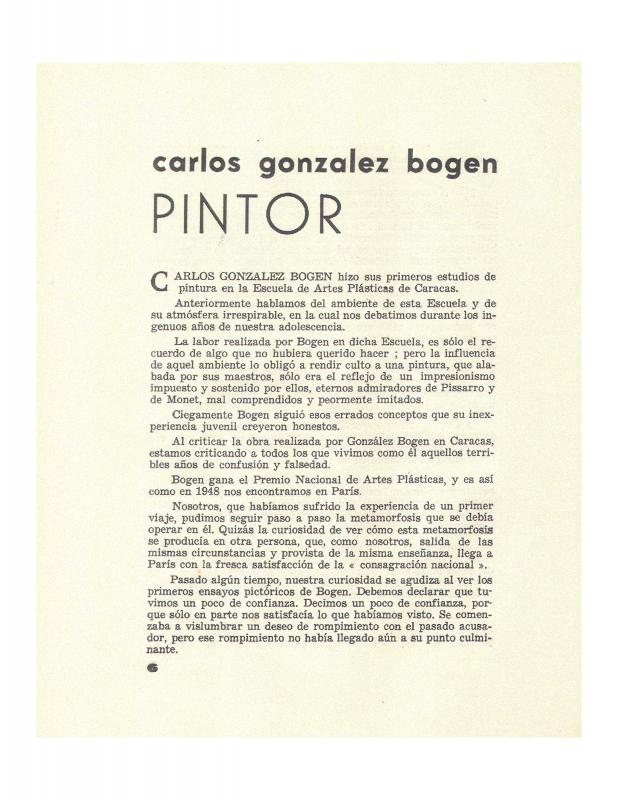Los Disidentes was a group started in Paris in 1950 by a number of Venezuelan artists and writers who lived there from 1945 to 1952. From their home base in Paris they decided to challenge the official education provided by the Escuela de Artes Plásticas de Caracas, which was based specifically on landscape painting and nativist art. In the spirit of their name, Los Disidentes sought to breathe new life into traditional and academic art through an assimilation of the values espoused by European abstraction. The painters in the group included the author of this essay, Alejandro Otero (see also “Gastón Diehl promulga y espera una resurrección del espíritu impresionista en Venezuela?” [doc. no. 813625], “Poetas: Críticos de arte” [doc. no. 813445], “Las ‘placas al mérito’ y la juventud” [doc. no. 813429], and “Mateo Manaure en la pintura: Un joven pintor venezolano, en viaje hacia París” [doc. no. 813639]), Pascual Navarro, Luis Guevara Moreno, Carlos González Bogen (“La escuela ‘de los paisajistas’ de Caracas” [doc. no. 813695] and “‘De nuevo’ Los Disidentes” [doc. no. 813667]), Mateo Manaure (“Carlos González Bogen: Pintor” [doc. no. 813583]), Narciso Debourg (“En torno a la pintura de hoy” [doc. no. 813597]), Perán Erminy (“Alrededor de la historia de ‘Los Disidentes’” [doc. no. 813463]), Rubén Núñez, Dora Hersen, and Aimée Battistini, as well as J. R. Guillent Pérez, who was a philosophy student at the time (“Lo latinoamericano y lo occidental [Parte I]” [doc. no. 813723] and “Lo latinoamericano y lo occidental: (Continuación)” [doc. no. 813478]). They were later joined by other Venezuelan artists such as Armando Barrios, Miguel Arroyo, Oswaldo Vigas, Omar Carreño, Alirio Oramas, and Régulo Pérez. They published a magazine, named after the group, Los Disidentes, which carried all their news, and appeared a total of five times.
Among works of Venezuelan critical literature that expressed the avant-garde thinking of the 1950s, “Del arte abstracto”—written by Alejandro Otero [Rodríguez] (1921–90), the painter, writer, and founding member of Los Disidentes—was one of the pioneering pieces of writing on the subject of Abstractionism. It ranks as one of the most important critical essays to have been produced during that decade by a Latin American painter. Over and above his critical skill, Otero here reveals his command of the form in question (the essay) and the methodological precision of his approach to historical research, expressing his points of view, in some cases, as historical laws or constants, and writing with a confident authority that is one of the hallmarks of his prose style. Otero’s essay clearly reflects his avant-garde pictorial opinion and his support for the ideas expressed by Los Disidentes in the four editorials that appeared in the five issues of the group’s magazine. Taken as a whole, these editorials present what could be considered the group’s manifesto. Otero’s essay also reveals his vocation for teaching, a passion that never deserted him, not even during his most controversial encounters. The essay is, in general, a well-finished work that stands on its own merits, despite the author’s assertion that, in his opinion, it barely provides “a superficial explanation of the origins of Abstract art” but that “(it will continue)”—though not in this essay.
This text is included in Alejandro Otero, Memoria Crítica, compilation and selection by Douglas Monroy and Luisa Pérez Gil (Caracas: Monte Ávila Editores/Galería de Arte Nacional, 1993).











